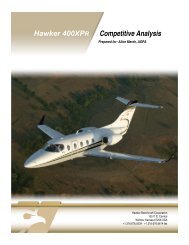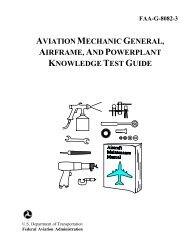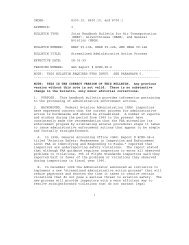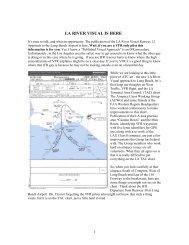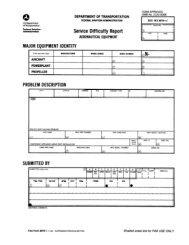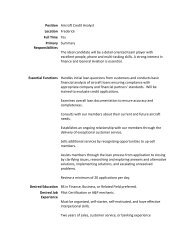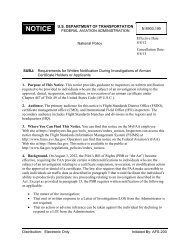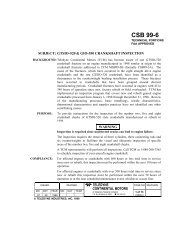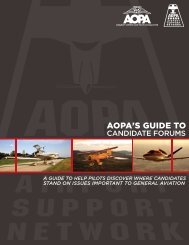2008 Nall Report - Aircraft Owners and Pilots Association
2008 Nall Report - Aircraft Owners and Pilots Association
2008 Nall Report - Aircraft Owners and Pilots Association
Create successful ePaper yourself
Turn your PDF publications into a flip-book with our unique Google optimized e-Paper software.
<strong>2008</strong> NALL REPORT<br />
The following aircraft categories, classes, <strong>and</strong><br />
operations are not included in each year’s <strong>Nall</strong><br />
<strong>Report</strong>:<br />
• FAR Part 121 airline operations<br />
• FAR Part 135 charter operations<br />
• Military operations<br />
• <strong>Aircraft</strong> weighing more than 12,500 pounds<br />
• Helicopters<br />
• Gliders<br />
• Balloons<br />
Figure 45 shows the FAA’s estimate of the number<br />
of powered GA aircraft that were active in 2007,<br />
sorted by category <strong>and</strong> class, separately for air-taxi<br />
operators <strong>and</strong> other GA users. The estimates of<br />
total flight time used in this report are based on<br />
92.6 percent of the GA fleet.<br />
Data on Pilot Experience<br />
Information on the total flight time of accident<br />
pilots may come from any of several sources of<br />
varying degrees of currency. Interviews with surviving<br />
pilots or examination of logbook entries<br />
are usually the most up to date; when these are<br />
not available, the experience claimed on medical<br />
certificate or insurance applications may be cited<br />
instead. Medical data are more recent (<strong>and</strong> thus<br />
show more flight time) for pilots who maintain<br />
higher levels of certification—within the past six<br />
months for a current first-class certificate but<br />
(in 2007) up to three years old for a valid thirdclass<br />
– <strong>and</strong>, like total flight time, medical class<br />
is associated with certificate level: Among the<br />
2007 accident pilots, more than three-quarters<br />
of first- <strong>and</strong> second-class medicals were held by<br />
commercial pilots or ATPs, while 85 percent of<br />
third-class certificates belonged to private or student<br />
pilots.<br />
Medical applications provide the only available<br />
information on flight experience across the entire<br />
U.S. pilot population. The most current data<br />
available from the FAA’s Civil Aerospace Medical<br />
Institute (CAMI) are based on each active<br />
pilot’s most recent application as of 2005. <strong>Pilots</strong><br />
were considered “active” unless their most recent<br />
medical certificate had been allowed to lapse<br />
from third-class status, at which point they were<br />
dropped from the data set. No effort was made<br />
to link the records of individuals, who were not<br />
identified in either the NTSB or the CAMI data;<br />
rather, the CAMI data provide a snapshot of the<br />
overall distribution of flight experience for each<br />
type of pilot certificate.<br />
The accuracy with which the 2005 data estimate<br />
the distribution in 2007 is not known, but there<br />
is reason to believe that benchmark figures such<br />
as the percentage of private pilots with less than<br />
500 hours do not change quickly. The steady increase<br />
of experience among active pilots is offset<br />
in some part by the entry of new certificate holders<br />
<strong>and</strong> the departure of experienced pilots who<br />
stop flying. Comparing the number of pilots in<br />
the lower experience categories with the number<br />
of new private <strong>and</strong> commercial certificates issued<br />
annually implies that the turnover in these groups<br />
is relatively slow.<br />
The complexity of the relationships between certificate<br />
level, total flight experience reported, <strong>and</strong><br />
the currency of those reports makes it clear that<br />
the numbers of accidents within flight-time categories<br />
must be interpreted with caution. More<br />
experienced pilots may be at greater risk of accidents<br />
simply because they fly more often. Many<br />
commercial pilots without ATP certificates may<br />
be building time rapidly while employed as flight<br />
instructors or crop dusters, exaggerating the difference<br />
between experience reported earlier on<br />
the medical application <strong>and</strong> actual experience on<br />
a given date. The role of flight experience as an<br />
accident risk factor seems less straightforward<br />
than previously supposed.<br />
The availability of time in type for accident pilots<br />
depends on the accident’s severity: Missing<br />
data are concentrated among fatal accidents. In<br />
2007, more than two-thirds of the accidents for<br />
which time in type was never determined were<br />
fatal, <strong>and</strong> time in type was unavailable for almost<br />
two-thirds of all fatal accidents (63 percent). The<br />
pattern was similar within every certificate level<br />
except student, <strong>and</strong> is not surprising: The pilots<br />
are often among the fatalities, <strong>and</strong> their logbooks<br />
may be lost or destroyed. Information is not as<br />
reliably available from insurance carriers, flight<br />
schools, company flight departments, or other external<br />
sources. For this reason, this report makes<br />
no attempt to analyze time in type among pilots<br />
involved in fatal accidents.<br />
32 33



